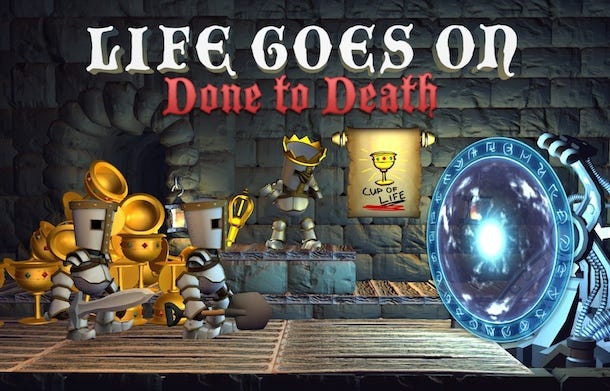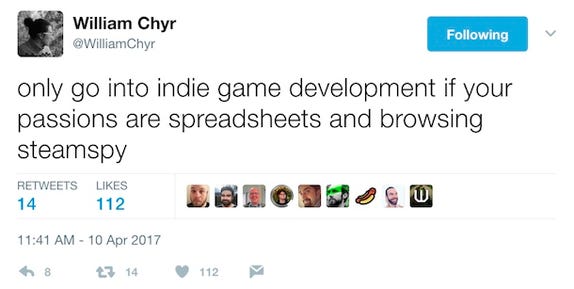
Featured Blog | This community-written post highlights the best of what the game industry has to offer. Read more like it on the Game Developer Blogs or learn how to Submit Your Own Blog Post
Missing the Mark: The Importance of Market Fit
Product/Market fit is critical in determining the success of a game. These are the things I wish I knew before developing a puzzle-platformer.


I thought we had a hit game on our hands. When we first showed it off, someone asked us how they could give us money. When we described the concept, people said they loved it. We won awards. We got media coverage. Sony, Nintendo, and Microsoft all expressed interest. We got access to Steam back when that wasn't such an easy thing to do. Success seemed certain.
If you've read this sort of article before, you probably know where this is going. Neither the 2014 Steam release of Life Goes On nor our second try with a 2016 expansion (Life Goes On: Done to Death) and PS4 port ever saw the level of sales that we expected. While I know that we have done better than many indie games, the results were disappointing even for a small team. Critically, we didn't make enough money for the studio to fund another game.
I would be the last person to say that we made a perfect game or that we ran the ultimate marketing campaign. But my belief is that for the quality of the game we made and the level of marketing success we had, the game underperformed relative to other games.
Life Goes On currently has a 96% positive Steam user score. It won awards including a PAX 10 selection, and the expanded release has a 77 on Metacritic. We put time and money into exhibiting the game and reaching out to the press. And we had some decent success with getting reviews and exposure. But all of this failed to translate to sales.
My impression that Life Goes On underperformed was further reinforced by Bill Borman's recent article on hidden gems on Steam. By his metrics, Life Goes On is number 55 on the list of Steam's top hidden gems.
Through trying to understand the sales performance of our game, I have developed an interest in market analysis that may border on the obsessive. I never thought I would ever spend so much time researching sales numbers and analyzing marketing pitches. I've come to understand that product/market fit is a huge factor in a game's commercial performance, and I'd like to share my thoughts on why Life Goes On isn't a good fit in the modern indie games market.

Analyzing the Product/Market Fit of Life Goes On
It was Ryan Clark, the creator of the excellent Crypt of the Necrodancer, that got me thinking in terms of the gaming market. If you haven’t read his What Makes an Indie Hit article, definitely do so. He also has a great Twitch stream where he discusses games and their market potential. Ryan gets credit for almost all of the ideas that I discuss in this article.
Here are the factors that I think were major influencers of our results:
Hooks
Hooks are the core of a game’s appeal to the market. They are what make a game special and different from other games. They are the reasons why a player might want to check out what you are doing. I think Life Goes On actually does well in this regard:
You have to die. Life Goes On reverses the typical meaning of death in a video game. A death is not a failed attempt; it’s something you must seek out, so you can progress in the game.
Using your own dead bodies to solve puzzles. Flinging a knight into a saw blade, so the body bounces and flops onto a button has a special sort of morbid appeal.
The game is funny. Even though the core mechanic is grim, the game doesn’t take itself seriously and is full of Monty Python-inspired dark comedy.
The strengths of these hooks and how people reacted to them at conventions are a big part of what encouraged us to develop the game. It was the enthusiasm that people showed for the game's concept and our approach that made us think we might have a minor hit on our hands.
On the other hand, that’s not a lot of hooks compared to games like Crypt of the Necrodancer or Darkest Dungeon. While our core concept is a solid hook, we don’t have a laundry list of additional things to get excited about. And while a striking or memorable name can also be a hook, "Life Goes On" isn't very strong, and this can't be doing anything to help with its market appeal.
Genre
If I had to point to the one thing that hurts Life Goes On the most, it would be its genre. When the project started in early 2012, puzzle-platformers like Braid, Limbo, and Fez were practically the definition of what a successful indie game was. In 2013, The Swapper, and even lower-profile titles like Nihilumbra, seemed to show there was a market for our game. But the market shifted with the greenlight floodgates opening and the rise of roguelike, survival, and crafting games. In 2014, selling a puzzle-platformer suddenly became a dubious proposition.

Analyzing the data on Steam Spy shows very few indie puzzle-platformer hits on Steam since 2014. I am aware of three notable exceptions:
Never Alone features absolutely beautiful art along with gameplay created in consultation with the Alaskan Native community based on a traditional folk story.
Seasons After the Fall has incredible art and animation designed to look like a living painting.
Inside, from Playdead, the studio that created Limbo, is a game with stunning and distinctive visuals.
I'm sure I am missing other puzzle-platformers that have done better than Life Goes On in this timeframe. There doesn’t seem to be many though, and few seem to have done really well.

These examples of success had big production budgets, groundbreaking visuals, and great marketing stories. Comparatively, earlier puzzle-platformers like Pid, Vessel, and Nihilumbra seemed to indicate a lower barrier to entry for success.

I know that Life Goes On doesn’t compete on the same level as Inside. But it’s a shock to discover just how high the quality bar is if you want to make a successful puzzle-platformer today. On top of that, while Inside’s sales are good, they aren’t great given how amazing the game is. Inside is missing from Steam's Top 100 Best Sellers of 2016, and that must be a disappointment for Playdead considering the size of the team and the number of years that went into the game's development.
Network Effects
In the mobile gaming world, people talk about apps going viral, with players influencing other potential players to try a game. I think this is an overlooked factor of success in the PC and console space. While a game’s quality and hooks can contribute to it spreading via word-of-mouth, there are other game features that contribute to how a game spreads.
Consider multiplayer. Have you ever been persuaded to buy a game because a friend wanted to play with you? Similarly, if you've played any of Zachtronics' games, you know how features like leaderboards can help a game spread virally. When I play TIS-100, I want to see my friends on the level leaderboards, so I can compare how well-optimized my designs are.
Level editors and mod support provide an opportunity for players to create content they are motivated to share. These sorts of features can help a community form around a game and potentially pick up momentum of its own.
Life Goes On doesn’t include multiplayer, a level editor, or leaderboards. So even if you really like our game, you aren’t likely to draw your friends into playing it. And the lack of these features makes it harder for a community to grow around the game. Building these features would have come at a price, and other aspects of the game would have suffered if we had included them. But I suspect if we had made a less-polished game that had these features, it would have sold better due to positive network effects.
Playtime

Having a long game with high replayability is unexpectedly important in the current market. These are obviously nice traits for any game to have, but it seems they have an outsized influence on a game’s sales relative to their importance to gamers.
 Steam is constantly showing me a popup that says a friend of mine is playing Spelunky. He has played it for almost 400 hours. And I have to say, constantly seeing that popup is a powerful endorsement. A game that you play for hundreds of hours means it is going to be on your mind for a long time, providing lots of opportunities for word-of-mouth marketing. Also, long playtimes contribute to maintaining an active player base, and this seems to play a role in what games get Steam Store feature space.
Steam is constantly showing me a popup that says a friend of mine is playing Spelunky. He has played it for almost 400 hours. And I have to say, constantly seeing that popup is a powerful endorsement. A game that you play for hundreds of hours means it is going to be on your mind for a long time, providing lots of opportunities for word-of-mouth marketing. Also, long playtimes contribute to maintaining an active player base, and this seems to play a role in what games get Steam Store feature space.
Consider Garry's Mod—a game released over ten years ago that was in the top 100 games of 2016. According to Steam Spy, it has an average playtime of 96 hours! A lot of other indie blockbuster games show a similar pattern. Terraria has an average of 78 hours, and Rust and Ark are both over 100 hours. Looking at the top 100 list, it seems pretty common for the top-selling games to have very high player retention.
Life Goes On has a comparatively short average playtime. There are a fixed set of puzzles in a fixed set of levels. Once you’ve played through the game once, you’ve consumed its content. Unlockable items and achievements offer some replayability, but this is limited. Making things worse, Life Goes On's level-focused design gives players an opportunity to put the game down every time they finish a level. This comes with the risk that a player may never return, further shortening average playtimes. This short playtime means that you won’t be talking about the game for months, and statistically you are unlikely to see your friends playing a shorter game on Steam.
Features that make for long playtimes like competitive multiplayer, procedural content, and super high replayability aren't a natural fit for a puzzle-platformer, and this likely contributes to why the barrier to success is now so high in this genre.
Estimated playtimes, in hours and minutes, of popular games. via Steamspy
Classic Indie Hits | Average Playtime | Median Playtime |
|---|---|---|
Limbo | 03:04 | 01:44 |
Fez | 03:18 | 01:11 |
Braid | 03:40 | 01:36 |
2016 Indie Hits | Average Playtime | Median Playtime |
Stardew Valley | 46:10 | 25:19 |
Rimworld | 61:25 | 28:47 |
Factorio | 62:45 | 26:29 |
Streamers
Streamers have become a tremendous force in the world of video game marketing. One result of this has been the rise of a 'Streamer Bait' genre of games designed to appeal to popular streamers. But beyond this, it makes sense that any game will benefit from being streamer-friendly.

On one hand, Life Goes On has a hook that is good for some laughs. But in almost every other way, it's in a bad spot when it comes to streaming. Puzzle games in general face an uphill battle. Getting stuck on a puzzle and banging your head against it until you figure it out can be rewarding for a player, but it doesn't make for exciting viewing material for an audience. Even worse, I think that puzzle-platformers may be hurt by streamer exposure due to low replayability. If someone watches a full playthrough of Inside, will they be compelled to buy it and play it for themselves? Or will they feel like they have gotten the bulk of the experience through watching someone else play it? Finally, playtimes factor in here as well. A long, highly-replayable addictive game will get streamed to audiences for hundreds of hours, gaining huge amounts of exposure. But even the most dedicated streamer can only play a short game a few times before they have exhausted the content.
Visual Design
Video games have a long history of sales being driven by graphics. People may think the indie scene gets away from this, but that doesn't seem to be true. It’s not a coincidence that my three examples for recent and successful puzzle-platformers look incredible. Visuals are the first impression your game gives, and it’s most obvious signal of quality.

Looking at Life Goes On's visuals, I think Ian, our primary artist, did an excellent job. There are many reviews that talk about the quality of our art and animations. We are instantly differentiated from a lot of indie games by having 3d graphics instead of pixel art, but there are also criticisms that our visuals are generic. I can understand this: Life Goes On does not have a super-unique or heavily-stylized look. The game doesn’t offer a new visual experience that people haven’t seen before. It is not enough for a game to be pretty. The best selling games tend to have visuals that are both distinct and fantastic looking.

Tone
It also seems that the Steam audience prefers more mature styles and themes. Looking again at the Top 100, there is a visible trend towards dark, gritty, and mature games.. There aren't a lot of silly or cartoony games on that list. Stardew Valley is one of the colourful exceptions, but there is still a lot of seriousness in Stardew's gameplay. Similarly, the Kerbals in Kerbal Space Program are cartoony, but the game itself is literally about rocket science. With Life Goes On we made the decision to go with a colourful, cartoony, and gore-free world. Even though a core theme of the game is death, the tone of the game and its humour is quite goofy. We had a lot of fun with this, but it seems that a bloodier brand of comedy or a darker, more serious approach would have had more market appeal.
Know Your Market
Looking at the major trends in what is selling well on Steam today, it seems that Life Goes On is positioned incorrectly for almost all of them. And these sorts of factors were something that we barely considered during development. When most people think of marketing, they think of promotion, advertising, PR, and creating awareness for a game. But marketing begins with creating a product that fits a target market. Life Goes On failed to connect with its target market and to fit into the top-selling trends on Steam, and I believe that is the biggest factor in its lack of financial success.
When I first started thinking about marketing for Life Goes On, I read a lot of advice about how I should know my target audience. But I didn't realize what that meant or how to do that. With the hope of helping anyone who is in a similar position today, I'd like to offer some ideas for things you can do to understand the current indie market.
Use Steam Spy to evaluate genres and how well games similar to yours have sold.
Watch the Clark Tank, Ryan Clark's Twitch stream, where he regularly reviews Steam’s top sellers list. He does loads of very insightful market analysis, and the stream is a great resource.
Watch TotalBuscuit's Co-Optional podcast that features popular streamers and regularly includes a segment where they review new releases on Steam and discuss their first impressions of the games they see.
Play Lars Doucet's SteamProphet. Making predictions and checking their correctness can give you an idea of how well you understand the market. And looking that the Steam store pages for huge numbers of upcoming releases can give you a feel for what works and what doesn't.
I'm certainly not suggesting that you look at what is popular and clone it to make money. If you are anything like most game designers I know, you probably have multiple ideas for different games you would like to make. Understanding the market lets you evaluate which of those ideas are more likely to do well and allow you to run a sustainable business. I think there is a happy medium to aim for between being a starving artist and completely selling out for commercial gain.

Conclusion
I'm convinced that Life Goes On ended up on a hidden gems list instead of a bestsellers list because of poor product/market fit. But I hope that my analysis can help other game developers avoid some of the mistakes that we've made. If you think there is anything that I’ve missed, please let me know. I’d love to hear about it.
Finally, please check out Life Goes On: Done to Death. We really are proud of it, even though it isn't the hit that we thought it would be. Thanks for reading!
Read more about:
Featured BlogsAbout the Author(s)
You May Also Like







.jpeg?width=700&auto=webp&quality=80&disable=upscale)








